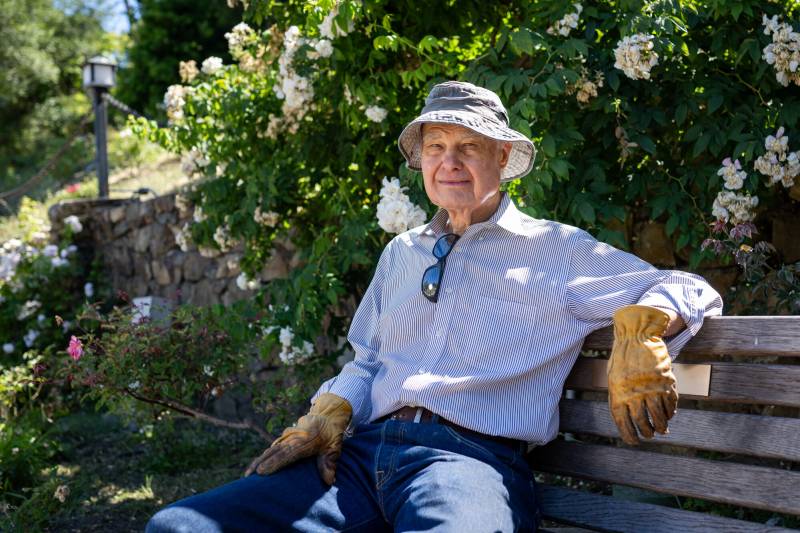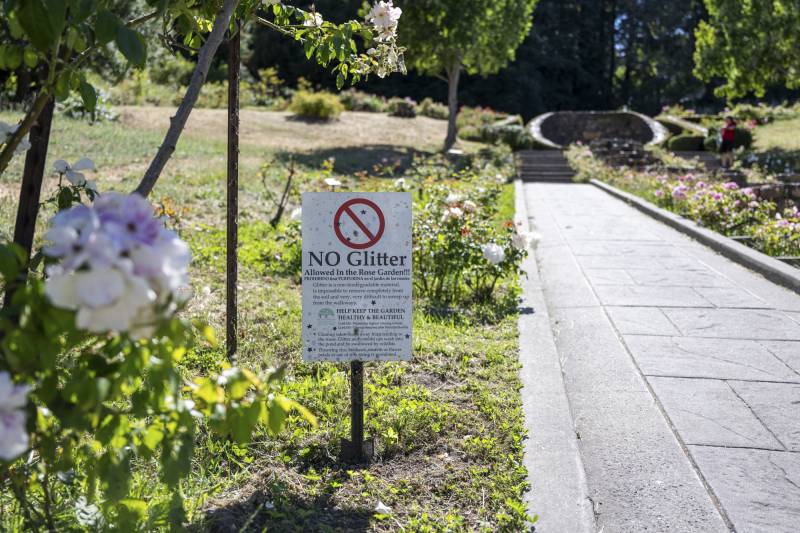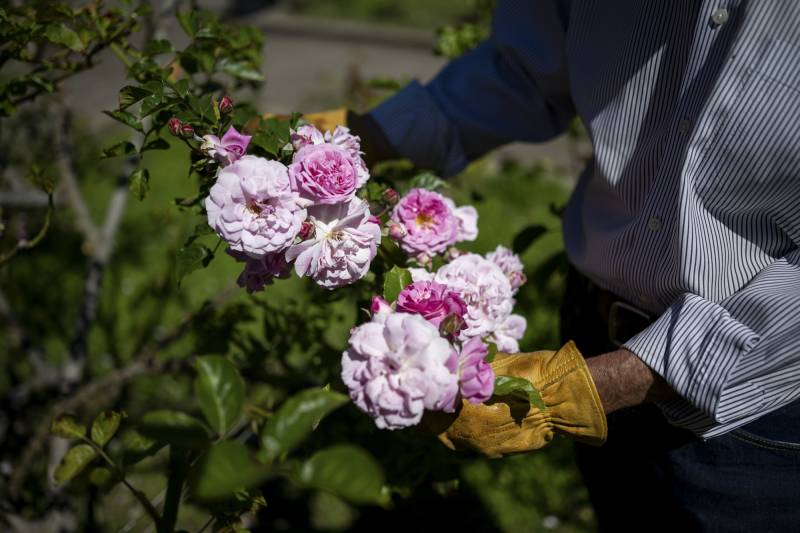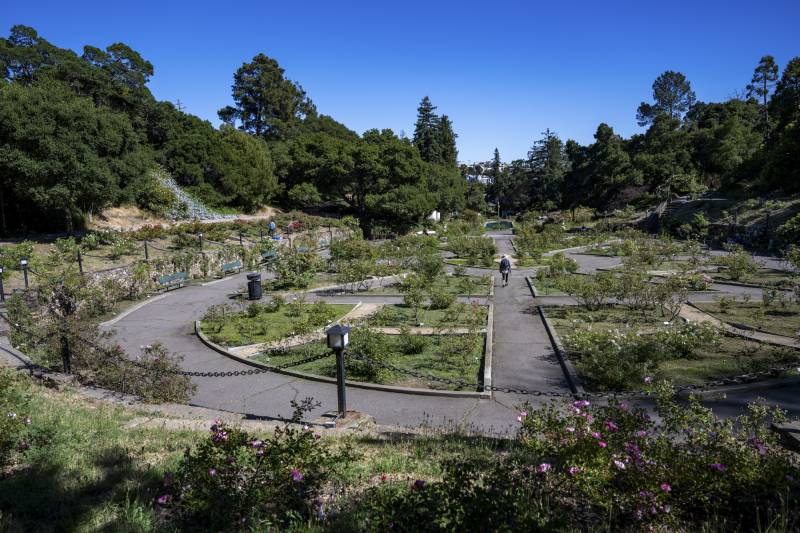Episode Transcript
Olivia Allen-Price: Welcome to Bay Curious, the show where we answer listener questions about the San Francisco Bay Area. I’m Olivia Allen-Price.
Olivia Allen-Price: Have you been to one of the beautiful rose gardens dotted around the Bay Area? Whether in San Francisco, Berkeley or San Jose, rose gardens are little escape from the hustle of life in a city. One example, in Oakland, is wedged between picturesque Lake Merritt and the Piedmont neighborhood.
Julia Fogelson: It really is just this gem, feels like a little European oasis here in Oakland.
Olivia Allen-Price: Bay Curious listener Julia Fogelson discovered Morcom Rose Garden only recently…
Julia Fogelson: Despite living, I don’t know, three blocks away for the last five years.
Olivia Allen-Price: From the outside, it’s easy to miss the garden altogether, but once inside, you are met with acres of open space and countless varieties of roses, blushing in pink, blue, purple and orange. Now, Julia likes to walk through the park on her way to work, and one day, she noticed an abundance of something sort of curious.
Julia Fogelson: I saw all of these signs that said no glitter.
Olivia Allen-Price: Pretty specific, huh? We thought so, too.
Julia Fogelson: I would love to know what happened at the rose garden to warrant so many signs.
Olivia Allen-Price: Julia’s question was selected by you, our listeners, in a recent public voting round on our website, BayCurious.org. So today on the show, we’re going in search of the story behind all those “No Glitter” signs at Morcom Rose Garden. Turns out that not all that glitters is gold. I’m Olivia Allen-Price. Back after this quick break…
[SPONSORSHIP MESSAGE]
Every hundred feet or so along the walking paths at Oakland’s Morcom Rose Garden, there are signs that say “NO GLITTER” in big letters. Bay Curious listener Julia Fogelson wanted to know why. We sent KQED’s Christopher Beale to Oakland to find out.
[sound of birds chirping]
Christopher Beale: In the Grand Lake area of Oakland, just a little to the northeast of Lake Merritt, if you know where to look, you’ll find Oakland’s Morcom Rose Garden. The address is 700 Jean St. Now, you also know where to look.
Christopher Beale: Out in front, you’re greeted first by a big sign welcoming you to the rose garden; there is a map there, too, to help you navigate the 7 1/2-acre site. In my case, I was greeted right away by the garden’s consulting rosarian, Royal Krieger. He’s who I’m here to meet.
Christopher Beale: Hi Royal?
Royal Krieger: Christopher? Yeah.
Christopher Beale: Nice to meet you!
Christopher Beale: You might be asking yourself, rosarian? What the heck is that? Well, Royal says basically that’s a rose authority.
Christopher Beale: How long have you been a rose authority?
Royal Krieger: Well, I gave my first rose-pulling demonstration here in 1985.
Christopher Beale: Royal is a volunteer, but he has a personal attachment to the rose garden and loves to give tours.
Royal Krieger: The land was purchased in 1912 by the city. It officially became a park in 1915.
Christopher Beale: In 1933, Mayor Fred Morcom planted the first rose here in the garden, and more and more have been added over the decades. There are currently about 6000 different rose plants in the garden, representing some common and some rare varieties of roses. Some of them are even delicious to local wildlife. The garden attracts deer, and they eat the roses.
Royal Krieger: Oh yeah. They certainly do. They’d love all the new growth in the roses.
Christopher Beale: What types of things do people use the Rose Garden for on a daily basis?
Royal Krieger: It’s a place for joy. Uh, we have a lot of kids that, before their proms, they meet here, and the parents will come and family, and they shoot a lot of pictures. Weddings, obviously, uh, quinceañeras and for many people also, uh, they live in apartments and uh, so it’s a place where they can get, get with nature, uh, nearby.
Christopher Beale: We got a question from a Bay Curious listener who’s a big fan of the garden, walks around all the time, finds a lot of peace here, and noticed that you have signs up throughout the garden that ban a very specific item. Do you know what I’m talking about?
Royal Krieger: Oh, I sure do. The glitter.
Christopher Beale: Yes. Okay, obviously, this brings up the question. It’s a very specific thing. Why do you have signs all over the garden that say “no glitter”?
Royal Krieger: Well, for whatever reason, uh, when people come to celebrate a birthday or graduation or whatever, it seems appropriate to them to bring, uh, glitter or, uh, confetti of some sort, and then they’re shooting the pictures, they throw it in the air, and then the wind blows it around. The glitter, which is the worst, is very small, and now they can get it in the form of a, like a bomb, and they fire this thing well up into the air,
[pop sound effect]
Royal Krieger: …and it spreads all over. It’s impossible to pick up. Now we got glitter all over in the beds. We’re concerned about birds and whatever being attracted to it. Plus, it gets into the water areas, and there’s some plugging issues, etc.
Christopher Beale: Is something about the glitter specifically bad for the roses, too? Like, does it actually harm the flowers?
Royal Krieger: Well, I mean, you’re introducing, uh, you know, little teeny particles of metal or, uh, you know, some, uh, whatever the glitter is.
Christopher Beale: Microplastics.
Royal Krieger: Yeah, micro, yeah, microplastics, you know, I mean, and, uh, that stuff just doesn’t, uh, you know, decompose and rot away. I mean, uh, so that’s, that’s the problem. Once it’s in there, I’ll turn the soil, and I’ll see glitter in there.
Christopher Beale: Mmm.
Royal Krieger: You know, and that was, that’s not good. And it’s not necessary. We finally had to put the signs up, and it’s been reasonably effective. We still have some problems but nothing like we used to have.
Christopher Beale: I don’t want to encourage this, but if you check Pinterest, you’ll see that this “glitter in a rose garden” photoshoot idea was and is a whole thing. Please do not do this.
Christopher Beale: How many times would you say you personally have had to clean up glitter in the garden here?
Royal Krieger: [laughs] I, I, you know, I, I didn’t go to Sesame Street, so I can only count so high, but it’s higher than that.
[laugh]
Christopher Beale: Julia, our question asker, met me at Morcom Rose Garden on a breezy afternoon. And I told her the whole thing about the history and the variety of roses and the weddings and the joy and the glitter. And I asked her what she thought.
Julia Fogelson: I would hope knowing that other people would refrain from using glitter since it does not, it’s not biodegradable.
Julia Fogelson: And you can just use AI or Photoshop at this point, right?
Christopher Beale: There are no more excuses to throw glitter around.
Julia Fogelson: Yeah, we don’t need analog glitter anymore.
[laughter]
Christopher Beale: Royal Krieger wants you to please come enjoy the sights and sounds and smells of Morcom Rose Garden, but just don’t celebrate in a destructive way.
Christopher Beale: What’s another fun way you might suggest that I celebrate joy here in the park that doesn’t harm the roses?
Royal Krieger: Well, you can breakdance on the, uh, walkways, I suppose.
Christopher Beale: Wait, can you do that?
Royal Krieger: No! [laughter]
Olivia Allen-Price: That was KQED’s Christopher Beale. Every month, we have a new public voting round-up at BayCurious.org, and today’s question was selected by you. Head online now to cast your vote for the latest round of questions. Here are your options:
Voice 1: I recently saw Komandorski Village on a map near Dublin. What is, or was Komandorski Village?
Voice 2: Who made the wave organ, and when is the best time to hear it?
Voice 3: How much do the billboards next to I-80 through San Francisco earn? And if it’s a significant amount, why doesn’t every skyscraper in San Francisco have a billboard?
Olivia Allen-Price: Again, vote at BayCurious.org. Big thanks to Julia Fogelson for asking today’s question.
Julia Fogelson: Bay Curious is made in San Francisco at member-supported KQED.
Olivia Allen-Price: If you’d like to support Bay Curious by becoming a member of KQED, head to KQED.org/donate. Thanks!
Katrina Schwartz: This episode was edited by Katrina Schwartz.



